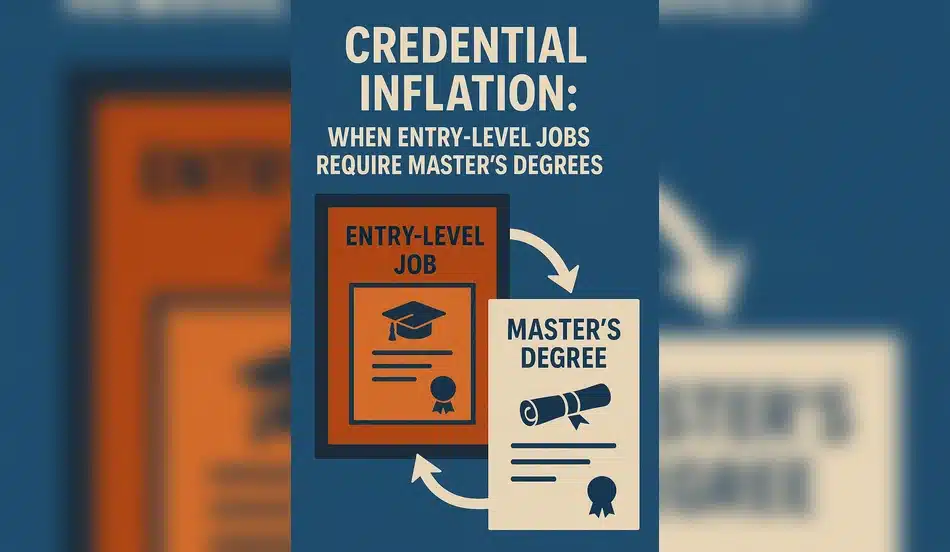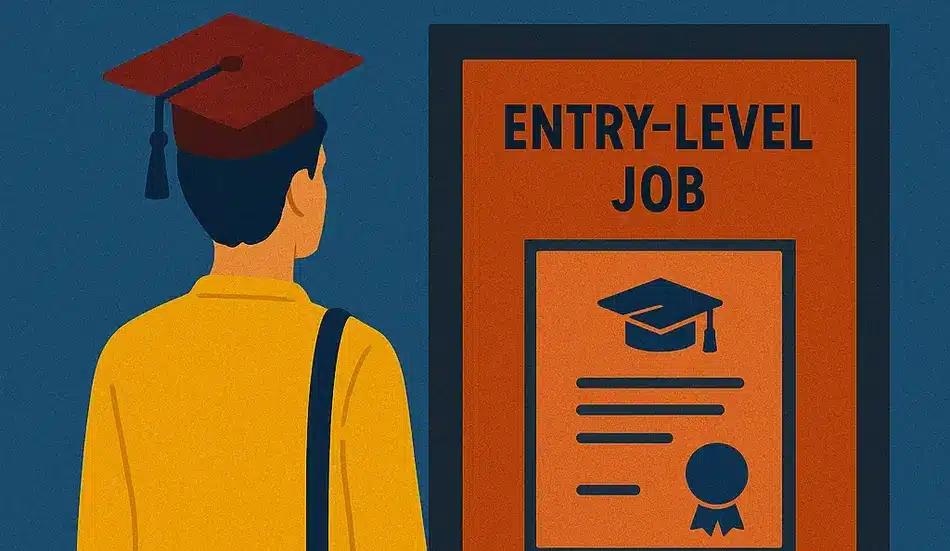In today’s job market, a bachelor’s degree is no longer the golden ticket it once was. Employers across industries are increasingly demanding master’s degrees even for entry-level positions, a trend known as credential inflation. This shift places additional burdens on recent graduates both financially and competitively while calling into question the true value of higher education credentials.
Table of Contents
What Is Credential Inflation?
Credential inflation occurs when the minimum educational requirements for a job rise faster than the skills actually needed to perform it. Once a bachelor’s degree sufficed for many professional roles; today, those same positions often list a master’s degree as the baseline qualification. As one Higher Education Inquirer analysis notes, “Where a bachelor’s degree once opened doors to managerial or professional roles, it now often leads to underemployment”.
How Widespread Is the Trend?
According to the U.S. Bureau of Labor Statistics, there are 40 occupations in which a master’s degree is now typically required for entry—up from just a handful a decade ago . In high-growth fields such as:
- Healthcare Administration: Hospital management roles that once required a bachelor’s now demand a master of health administration (MHA).
- Social Work: Clinical social worker positions increasingly stipulate a master’s in social work (MSW).
- Data Analytics: Junior data-analyst and research-assistant jobs often list a master’s in data science or statistics as mandatory.
This expansion of master’s-level requirements has outpaced growth in overall job openings, effectively narrowing the candidate pool for those without graduate degrees.
Why Are Employers Raising the Bar?
1. Screening and Risk Aversion
In crowded applicant markets, hiring managers use degree requirements as an initial filter. A master’s degree signals advanced training and “seriousness,” reducing the perceived risk of hiring an inexperienced candidate.
“Employers often equate higher degrees with reliability, even for routine tasks,” says an HR executive at a Fortune 500 firm.
2. Algorithmic Job Posting
Many companies rely on applicant tracking systems that scrape resumes for keyword matches. A job posting specifying a master’s degree will automatically discount applicants without that credential, reinforcing the cycle of rising requirements.
3. Perceived Complexity of Tasks
As roles evolve—incorporating data visualization, cloud tools, or regulatory compliance—employers justify higher credentials by pointing to added responsibilities. Yet research indicates that many duties remain at the same complexity level as a decade ago .
🎓 Feeling Overqualified for Entry-Level Jobs?
Credential inflation is making job hunting harder — even for highly educated candidates.
Explore roles on WhatJobs where skills and experience matter more than just degrees, and discover employers hiring fairly in today’s competitive market.
Whether you hold a bachelor’s or master’s, we connect you with job opportunities that match your true potential.
👉 Browse fair-hiring jobs now — and land the role you deserve.The Impact on Recent Graduates
Financial Burden
Pursuing a master’s degree adds substantial costs. Average master’s tuition in the U.S. exceeds $30,000 per year, often requiring students to incur additional $20,000–$40,000 in debt. This debt burden weighs heavily, especially on first-generation and low-income scholars.
Talent Pool Constriction
When entry-level roles demand graduate degrees, capable bachelor’s holders are sidelined. Indeed job-search data shows a 20% decline in applications to certain administrative and analyst positions when master’s requirements are added .
Underemployment and Skill Mismatch
Even master’s graduates may find themselves performing tasks that do not leverage their advanced training—creating underemployment. A Business Insider survey reports that 41.2% of recent graduates are in jobs that do not require their level of education .

Who Is Most Affected?
- First-Generation Students: Less likely to afford or consider graduate school, narrowing their career prospects.
- Minority and Low-Income Workers: Financial barriers deter many from pursuing costly master’s programs.
- Career Changers: Professionals seeking new fields face an additional year or two of schooling before eligibility.
This dynamic risks exacerbating socioeconomic disparities, as advanced credentials become gatekeepers rather than markers of genuine skill.
Sector Snapshots
Healthcare and Social Services
Positions like healthcare project coordinator and behavioral health technician increasingly list a master’s in public health or social work—roles historically accessible with a bachelor’s and on-the-job training.
Education and Nonprofits
Entry-level program managers and grant-writing positions often require a master’s in education or nonprofit leadership, despite many tasks centering on coordination and communication skills.
Finance and Professional Services
Even analyst roles at consulting firms have shifted from “bachelor’s preferred” to “master’s required,” reflecting credential inflation rather than substantive changes in job duties.
Alternatives to a Master’s Degree
To sidestep time and cost barriers, many workers pursue:
- Micro-Credentials and Nanodegrees: Short, skill-focused programs (e.g., Google’s Data Analytics Certificate) that cost a fraction of a master’s and emphasize practical abilities.
- Professional Certifications: Industry-specific credentials (e.g., Certified Financial Planner, Project Management Professional) that are widely recognized by employers.
- On-the-Job Training & Apprenticeships: Structured programs that build skills while earning a wage, offering pathways into roles without graduate education.
These alternatives can signal competence to employers without imposing the same financial and time commitments as full master’s programs.
Policy and Institutional Responses
1. Transparency in Job Postings
Advocates urge employers to clearly distinguish between “required” and “preferred” qualifications, reducing unnecessary credential barriers.
2. Public Funding for Apprenticeships
Expanding federally and state-supported apprenticeship models can provide skills training for high-demand roles without a graduate degree.
3. Higher Education Reform
Universities are exploring accelerated master’s tracks—combining bachelor’s and master’s work in a five-year program at reduced cost—to mitigate debt burdens.
The Future of Credential Requirements
As AI and automation reshape job responsibilities, credential inflation may intensify—unless employers recalibrate their expectations. Data from research firm Jobright shows that 66% of job seekers prioritize skill‐based hiring over degree requirements when given the choice. Companies embracing this shift can tap into a broader talent pool while reducing educational inequities.
Mechanisms such as skills‐based job frameworks, which define roles by concrete competencies rather than degrees, offer a promising path forward. These frameworks support inclusive hiring by valuing demonstrated ability—portfolio work, project outcomes, and hands-on experience—over formal credentials alone.
Credential inflation represents a growing mismatch between educational attainment and job requirements. By rethinking hiring criteria—shifting toward skills and experience over blanket degree mandates—both employers and job seekers can foster a more equitable and efficient labor market.
For more insights on career trends, education policy, and workforce innovation, visit WhatJobs News.
FAQs
Q: What is credential inflation?
A: Credential inflation refers to the rising educational requirements for jobs that have not significantly changed in duties or complexity.
Q: Why are master’s degrees required for entry-level roles?
A: Employers use degree requirements as filters, rely on automated screening systems, and cite perceived task complexity, even when core responsibilities remain unchanged.
Q: How can job seekers compete without a master’s?
A: Focus on micro-credentials, industry certifications, apprenticeships, and building demonstrable skills through internships or project portfolios.
Q: What can employers do to reduce unnecessary barriers?
A: Clearly label “preferred” vs. “required” qualifications, adopt skills-based hiring frameworks, and partner with training programs to develop targeted talent pipelines.




